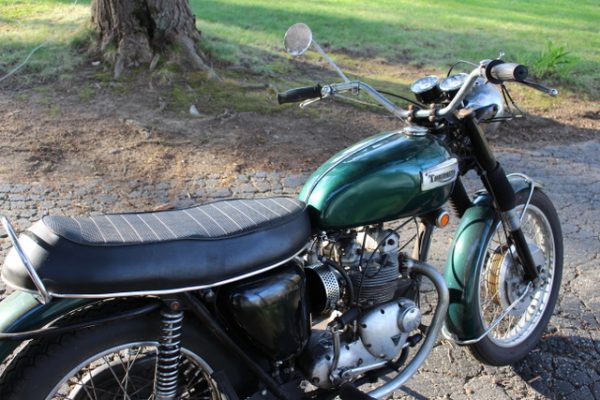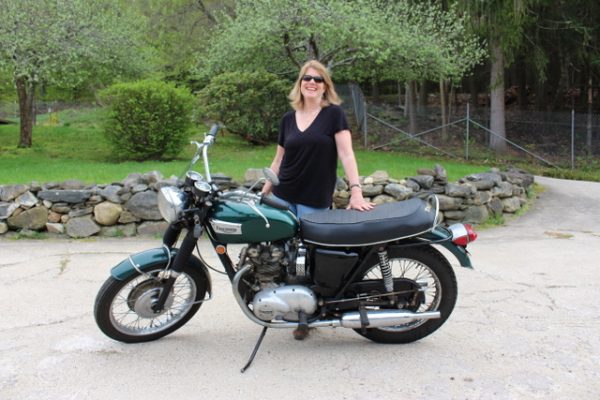Laura Werntz had gone to her car for a few moments to apply lipstick and to brush her hair before getting photographed with her newly-purchased first  motorcycle, which was parked on its side stand outside of a garage at the shop of vintage Indian expert George Yarocki in Torrington. Minutes earlier, she had handed me an envelope stuffed with $50 and $100 bills in return for a signed bill of sale.
motorcycle, which was parked on its side stand outside of a garage at the shop of vintage Indian expert George Yarocki in Torrington. Minutes earlier, she had handed me an envelope stuffed with $50 and $100 bills in return for a signed bill of sale.
As I waited to snap her picture on that day earlier this month, I was struck by intense melancholy seeing the vintage Triumph before me and knowing that it was no longer mine. Had I really just sold the 1969 Triumph T100R Daytona that I’d worked so long and so hard to restore? How could I have relinquished “This Old Bike” after putting hundreds of hours into making it road-worthy again? Was this truly grief I was feeling? The answers were “yes,” “on an impulse and with great difficulty” and “yes.”
Longtime readers of RIDE-CT will recall the tale of the Triumph – how on a cold winter day in January 2008 the then-battered 500cc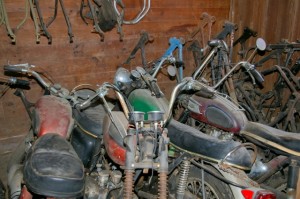 bike was pulled from a snarl of bikes in a shed behind Toymaker’s Café in Falls Village. It had 8,754 miles on the odometer and displayed a California license plate that revealed that it had last been registered in 1971.
bike was pulled from a snarl of bikes in a shed behind Toymaker’s Café in Falls Village. It had 8,754 miles on the odometer and displayed a California license plate that revealed that it had last been registered in 1971.
Some 37 years later, with the help of friends Greg Bidou and Carl Foster, we had dragged it to an unheated workshop across the parking lot. Greg had acquired the relic from a defunct dealership in Tennessee and had agreed to sell it to me for $1,250 as well a head a restoration team that would include Foster, myself and Robert “Tike” Ladd, owner of the Classic Motorcycle Co. in Terryville.
The rebuild was chronicled in soap opera fashion in RIDE-CT in “The Republican-American” newspaper over the next ten months or so under the heading of “This Old Bike.” The premise behind the series was that even a guy who didn’t know how to wrench – namely me – could acquire some skills and have some fun with proper guidance and supervision. 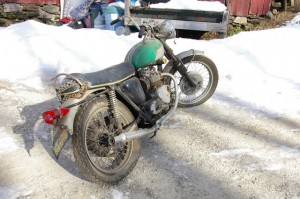 So why did the bike finally get sold nearly six years later? The short answers are lack of use and a buyer suddenly materialized.
So why did the bike finally get sold nearly six years later? The short answers are lack of use and a buyer suddenly materialized.
Werntz is close friends with Tim Raindle, an Indian-loving Englishman who stokes his knowledge of old Indians under Yarocki’s tutelage whenever the U.S. government grants him a visa. It was at Raindle’s urging that she’d taken and passed the state’s Basic Rider Course. The next step was to find her a bike. Despite advice from Raindle and myself that she buy something used, reliable and recent, she insisted on driving to my house when she heard that I had an old Triumph gathering dust.
Three days later, I received an email from Werntz saying that she’d pay the $3,000 asking price. I transported it to Yarocki’s shop so that Raindle could tinker with it as last season the Triumph experienced issues – a sudden loss of power once it got warm, for instance – that were fully disclosed from the outset.
As I waited to take pictures of Werntz, memories from the restoration and the bike’s subsequent use came to mind:
– The fascination at how Ladd was able to use a uni-spotter to weld pins on to dents in the gas tank and remove them.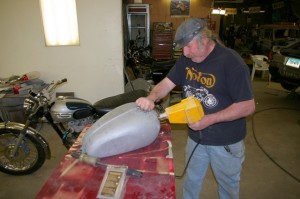
– The angst when a workshop visitor dropped the repaired and freshly-painted gas tank and we watched it roll across the wood floor.
– The tedium at the countless hours it took to disassemble the bike and clean every part before the actual rebuild could commence.
My most vivid and pleasing memories were of Greg, who owns Toymaker’s Cafe with wife Annie, gruffly guiding me through the rebuild process and of him test riding the Triumph. Although I found riding it to be a hoot, my top memory of the bike was watching Greg ride it. The café keeps him busy and he rarely gets to ride anymore. The rebuild gave him an excuse, if only briefly.
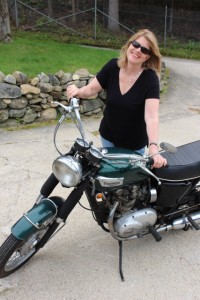 Maintaining the Triumph was less fulfilling and, over the years, I rode it less and less. At the time of the sale, the odometer read 10,584. It had been ridden 1,830 miles since being put back on the road – or about 300 miles a year.
Maintaining the Triumph was less fulfilling and, over the years, I rode it less and less. At the time of the sale, the odometer read 10,584. It had been ridden 1,830 miles since being put back on the road – or about 300 miles a year.
So why did Werntz was to buy it? “I’m a woman. I don’t think rationally,” she said, laughing as she said it. She later asked that I not use the quote, but I convinced her otherwise. How many riders ever think rationally when it comes to buying and selling motorcycles? I dare say that none of us do.
Actually, it was images of Steve McQueen on a Triumph, the bike’s green color, its shape and simple nostalgia that sold her on the T100R. “The color’s right. My first car was green. I always wanted a green MGB,” Werntz said. “It’s good looking.”
She maintains that she has plans for the Triumph, although I’d feel better if she drained the gas and oil, put it in the living of her home in Falls Village as an object d’art and got something else as her first road bike. “I think motorcycle museums are sad. I plan for it to be ridden,” Werntz said.
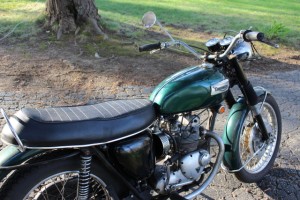 As I recall, the total cost of buying and putting the Triumph back on the road was about $6,000. However, I don’t judge the project to simply be a monetary loss. It was an education, a priceless life experience and a lot of fun. Last Sunday, when I stopped at Toymaker’s Café and asked Ann Bidou if she could forgive me for selling the Triumph, she responded warmly by asking what my next project might be?
As I recall, the total cost of buying and putting the Triumph back on the road was about $6,000. However, I don’t judge the project to simply be a monetary loss. It was an education, a priceless life experience and a lot of fun. Last Sunday, when I stopped at Toymaker’s Café and asked Ann Bidou if she could forgive me for selling the Triumph, she responded warmly by asking what my next project might be?
If she looked in my garage this morning, she’d see a 1982 Yamaha XT250. A neighbor wants $500 for it. I’ve already drained the gas, changed the oil, cleaned the air filter and removed a cracked chain guard. Getting it going should be a snap.
(Originally published in “The Republican-American” on May 24, 2014.)
 Ride CT & Ride New England Serving New England, NYC and The Hudson Valley!
Ride CT & Ride New England Serving New England, NYC and The Hudson Valley!

